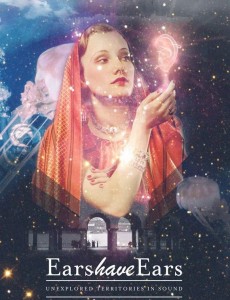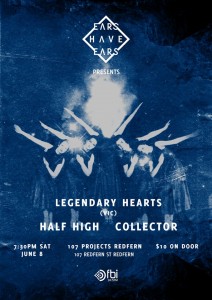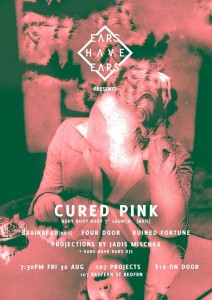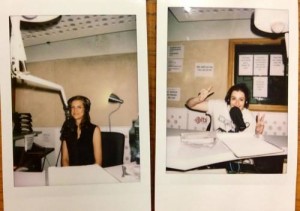Experimental music – one of those turns of phrase that can strike terror into the heart of even the most open-minded music enthusiast. Whilst a fear of the unknown seems the likely cause, it is more probable that the sheer breadth of what is dubbed “experimental’ pushes the genre boundaries so far apart that there can be no recognisable reference points left to cling to. And yet, it is this very same ocean of potential, of new sounds, of ideas (some new, some old and some reborn) that can be so enticing for the willing and ready listener. At this vertex of things previously unheard, Ears Have Ears have chosen to dwell.
A weekly two hour show on local Sydney favourite, FBi radio, Ears Have Ears: Unexplored Territories in sound actively showcases experimental music and sounds, and does so in an inventive manner by actively engaging with format, performance and collaborations. Each program, presented by Brooke Olsen and produced by Scarlett Di Maio, involves a unique performance created specifically for the program, which in and of itself is gutsy and creates an immediate point of interest for the program.
The success of their approach has a broader appreciation too – Ears Have Ears has gathered significant attention and respect since its establishment only a couple of years ago, having already won two Community Broadcasting Association of Australia (CBAA) Voxie Awards for Best New Program (2012) and Excellence in Music Programming (2013). Alongside winning such accolades, Ears Have Ears continue to convincingly embrace and broadcast thought-provoking and innovative music, effectively making the program FBi’ flagship experimental music program.
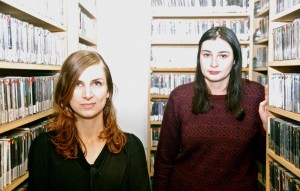
Olsen and Di Maio’ engaging approach is at the centre of what propels the momentum of the show as it continues to commission and broadcast imaginative outputs from Australian and international artists. Drawing on a rather stellar crew of guests and soundtrack contributors, Ears Have Ears has presented music by artists as diverse as Guerre, Pimmon, Nun, John Elliot (USA), Lawrence English, Super Critical Mass, Nurse with Wound, Scanner (UK), Treasure Hunt (USA), and John Chantler, amongst others.
As a long-time audience member and occasional dabbler in performing experimental music, my initial interest in Ears Have Ears straddled an inquisitiveness about edgy radio programming and the opportunities afforded innovative radio presenters and producers – to be curators, promoters, even provocateurs – to stir up these music scenes, bring their outputs to new audiences, but still not directly occupy the same realm as the artists featured.
To find out more, I began at the beginning.
Melonie Bayl-Smith: Tell me how the idea of Ears have Ears came about.
Brooke Olsen: I’d been involved in doing radio about experimental music for years, and then a position came up to be an executive producer on an FBi show called Sunday Night at the Movies. This show focused on having people make specific content for the show – sound art, spoken word, radio plays, things along those lines. Scarlett came on board after the previous presenter of the show ended up wrapping up, and so I then became the presenter and Scarlett took over as the executive producer.
Scarlett Di Maio: About three years ago I’d been volunteering at FBi and after a few months I was trying to figure out how I was going to fit in at the radio station. One of the office managers, who knew I was into experimental music, told me about an executive producer role that had come up for Sunday Night at the Movies. So a meeting was arranged with the programming director and various others, and this is where I met Brooke. We immediately clicked, and knew we were on the same page when we discovered that we had a common love for cLOUDDEAD – an cool but obscure US experimental hip hop band that was active about ten years ago. I knew nobody else who had even heard of them, so I took it as a sign that there was a synergy ready-made!
So we starting working together, sharing more and more ideas of how we wanted the show to move forward. After a while we decided to rebrand the show, to give it a bit more life, and that’s when it became Ears Have Ears…
BO: But we also were working on other projects alongside this as well – I had been running Dirty Shirlows and then was organising the Sydney component of the International Noise Conference with Lucas Abela who runs Dual Plover. Scarlett worked as a volunteer on the conference with me, as well as some of the Dirty Shirlows projects, and she really was amazing. We have a similar vision, even though we both have different taste in forward thinking, contemporary music, and Scarlett was able to maintain that vision on these projects.
Melonie Bayl-Smith: So what brought you both to the point of being interested in experimental music, and then to take that step further of being advocates, in a way?
BO: Mmm, difficult to say – I used to attend a lot of punk shows, and then started going to shows in warehouses where I came across this strange music, unlike anything I’d heard before. Then I started studying Media Arts Production at UTS where I was exposed to a pretty engaged group of people who were really active in experimental music and sound art. There were these monthly shows called “Disorientation’ where emerging artists and musicians undertaking their degrees were playing with established acts such as Severed Heads, and The Loop Orchestra, amongst others.
SDM: I’ve never been just interested in experimental music, I’ve always had a love for music in general, starting off as a classical musician and singer when I was younger. Music theory and musicology was of great interest to me when I commenced my university studies. After a while, I wanted to see how far I could explore sounds, and this lead me to becoming very interested in John Cage’ work and his ideas of sound in relation to noise music. It was at this point that I discovered bands such as Throbbing Gristle, for example. Once I began learning about the ideologies behind why bands were creating noise music, these theories on sound – this really blew me away and I wanted to explore everything about experimental music.
Melonie Bayl-Smith: So, the format of the show – I imagine that this has evolved as a response to your interests in experimental music and how you have worked with different artists.
BO: The ideas with the show originally was to have an artist create a long-form original piece, and then around this main work play shorter experimental, “thinking’ music. That format of having the feature piece, feature contribution, hasn’ changed much since we started – it would be an odd show where we don’ have a feature contribution. The music that we play on the show has changed a little bit since we started.
Is that change a response to the artists or because of yourselves?
SDM: Probably a bit of both – every week we have a particular type of artist – an electronic artist, a contemporary classical artist, a sound artist – and we’re always saying that we want to feature a completely different sub-genre the following week. We’ve played output from so many different sub-genres within experimental music, but we’re always looking to expand these investigations, to find someone doing something undiscovered.
Just picking up on this idea of ever-broadening the potential “playlist’, what kind of challenges does this uncover in terms of holding or building an audience? Does your program irritate people?
BO: (laughs) A while ago we were playing a pre-recorded longer piece, and throughout the broadcast as well as after it, we received some persistent text messages expressing a complete dislike for the work. But that’s pretty rare, really. On a programming level, if we know that the key piece sits within the electronic music realm, we will give consideration to ensuring that the other music we play in the program that week is different – different instruments, approaches, acoustic instruments, etc… A common thread for me, through all of the music we play is an exploration of new sonic possibilities. All the musicians whose outputs we broadcast are working beyond traditional notions of “music’ or subverting these notions, even if there is a strong sense of “musicality’ to their work. If the audience is robust enough, they will recognise this too.
Melonie Bayl-Smith: Have you had feedback from the artists that the process of being invited to produce a work for Ears Have Ears has pushed them into spaces and sounds they hadn’ explored previously?
SDM: We like to approach a range of artists, particularly emerging artists – alongside the more established artists or collaborations. It ranges from the very local to international artists who are perhaps touring Australia to independent, burgeoning acts from regional locations. And when we speak to labels and artists overseas, they’re very excited about the format of the show, that the idea of commissioning a soundtrack for live airplay is sufficiently innovative and singular, it makes the show attractive to others in varied contexts. We have built a range of contacts in different places.
BO: For example, Stacey Wilson who is Regional Curse is about to put out a release on the American label Not Not Fun, and the release is based on a soundtrack she did for Ears have Ears last year. In a similar vein, Primitive Motion recorded entirely new material for the show earlier this year – and this output ended up becoming material for five songs, released as an EP a few months ago. And then Andrew Tuttle released his own soundtrack for Ears have Ears as an independent work available online to his fans.
SDM: And then we’ve also had Sydney artist Guerre whose better known work is certainly not experimental but who has recorded a soundtrack for us and been a “genre crosser’. This both exposes the music played on Ears have Ears to a potentially broader audience, and positions the program in a less esoteric manner.
Melonie Bayl-Smith: Do you ever think that you are on a search to find an unknown gem? And how do you deal with the need for diversity in your playlist, avoiding that temptation to just play the music that you personally prefer?
SDM: Yes… we’re always considering that. We also see Ears have Ears as being “archival’ in a way, collecting and housing these “bespoke’ soundtracks that are naturally different from each other.
BO: Scarlett’s pretty amazing at trying to connect the music we play to a wider FBi audience. For example, Guerre recorded a soundtrack for us which was amazing, but he’ also had a lot of airplay on FBi as Guerre and also as Cassius Select. So that is one way that we create those connections – we want the program to showcase music that is forward thinking and innovative, but doing it in a way that is accessible. So there are pieces that we play on the program that are “difficult’s listening, but we try not to make everything so niche such that people turn off – opening up the audience for experimental music to a broader listenership.
SDM: Ears have Ears has always been about non-exclusivity.
BO: Musically, our playlists span the whole gamut of “experimental’ from meticulously constructed, internationally acclaimed sound art to lo-fi, gritty, weirdo drone recorded in a bedroom somewhere nondescript.
Melonie Bayl-Smith: From a broadcasting perspective – how do you see yourselves within the greater project of what FBi is about?
SDM: I think first of all, Brooke and I have always felt that FBi really support what we do on Ears have Ears.
BO: They give us a lot of freedom, it is fantastic doing a show on FBi – the broadcast footprint is so huge and it is really well set up, it is such an organised station. We know that we can make radio and know that we are able to access an audience. We do keep in touch with FBi about festivals, and make sure that Ears have Ears is covering major events that are within the radar of the average FBi listener, which gives us currency.
SDM: We also make a point to be across the local and international new releases that will be relevant to the focus of our show and to our listeners. On the flipside, we do try to avoid being “city-centric’ in order to showcase a diversity of talent and acknowledge people working in different ways, at different scales. We want to be welcoming and inviting to people who are listening, no matter where they are located.
Melonie Bayl-Smith: And what about radio as a format? Where do you think it is at?
BO: It’s changed a lot in terms of what people as far as what people get out of it as a medium. Radio is not so much a disseminator of information: with the internet and so forth this has really subsided. We try to compliment what is “on air’ with what is online – for example, we post most of the soundtracks produced for the show on our Soundcloud page. It is said a lot but I do think there is a place for radio, that the radio producer or radio DJ is a curator, a facilitator of sound, a tastemaker in a way. Community radio is really good at doing these things.
SDM: And radio, it’s still a great place for discovering new music, about learning more about music.
BO: Yes, there’ some really incredible shows happening across Australia on community radio at the moment – especially ones focusing on experimental, DIY, independent music, such as “O Tomorrow’ on 3RRR in Melbourne and Underground Australiana on 4ZZZ. I’m really excited about what is happening at the moment, especially as there’ a broad range of musical outputs showcased on these two shows alone.
Melonie Bayl-Smith: One of the other interesting elements of radio is the “curatorship’ that is evident – you hear one piece of music, and then another, sometimes being confronted in such a way that the response is “wow, never thought I’d hear this…and then that!†I also think that one learns more when contrasting things are placed next to each other. For example, often the best curated art shows are those which use juxtaposition to shock and surprise, and that reaction allows you to learn something new, even from something familiar or well known.
BO: We actually agonise over the tracklist for Ears have Ears each week, we spend a lot of time putting the order of the show together so as to create a flow… without making it …’samey’…
Melonie Bayl-Smith: In doing that is there a strong sense of purpose to each week’ broadcast?
BO: Well yes, and I think the other thing to note is that we are very conscious, without being tokenistic about it, that we are inclusive and properly representing the field. For example, we want to have a certain number of female artists, Sydney artists, artists working in specific genres or parts of experimental music. That intent really forms part of the show as well. It is important for us to engage with better known artists, say Ben Frost or The Necks, alongside say a lesser known, emerging artist such as Sydney tape music artist Lortica. This allows the Ears have Ears playlist to be balanced and not overly obscure.
Melonie Bayl-Smith: You talk about feeling a responsibility about bringing new music and interesting explorations to a broader audience even when there are other, better resourced broadcasters out there. Considering there is such a huge range of performance modes, resourcing and aesthetics – really it is just so broad – how do you feel about taking on this monster called “Experimental Music’?
SDM: I see it in quite a positive light there – whilst experimental is difficult territory, there is so much that can be called experimental music. We feel blessed to have a platform that FBi provides us to have two hours to play what we want every week and we want to take this opportunity seriously. Back to the discussion about Guerre – after we played the soundtrack he recorded for us, we had a lot of positive feedback from Guerre fans, who would never say that they liked or listened to experimental music, but then commented that Guerre’ soundtrack had really opened up music for them – and this is incredibly exciting for us. In terms of contemporary experimental classical music – we do put these types of works into the show but without making it too academic. We really avoid making it inaccessible – and we also aren’ trying to make ourselves out to be “the experts’ or the “authority’. We do our best to navigate our way around the genre and always try to remain open minded and inclusive.
In tying up the loose ends of the interview, I ask Scarlett and Brooke about the program name, Scarlett giving me a short anecdote about an album track by the band BEAK>, a side project of Geoff Barrow (Portishead). Pressed to spill my own answer, I confess my long-winded musings on their program’ moniker, telling them that when I saw the name Ears have Ears, it prompted me to think about an idea of “hearing beyond what you hear’, the difference between hearing and listening, and the possibilities obtained by “the listening’ beyond “the hearing’. That listening is about diving into the sound, to engage and critique, to find out what it is that you need to know about the sound, or what it is communicating to you: a peeling off of the aural layers.
With that explanation, Ears have Ears’ protagonists both laugh, saying that they couldn’t have described it better themselves and that they hope the show fulfils such lofty expectations. With their imaginings regularly becoming reality, they are doing all that – and then some.


